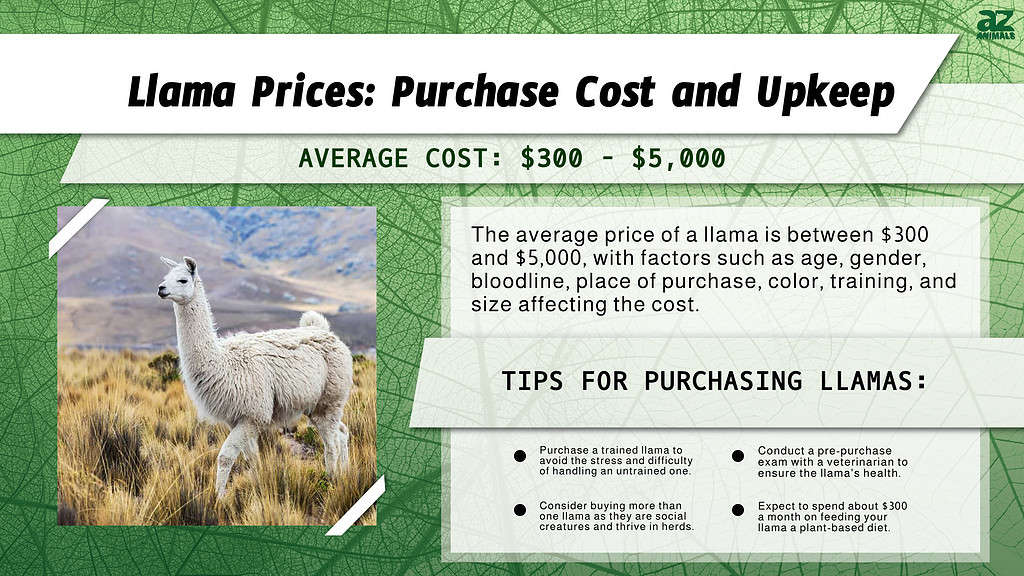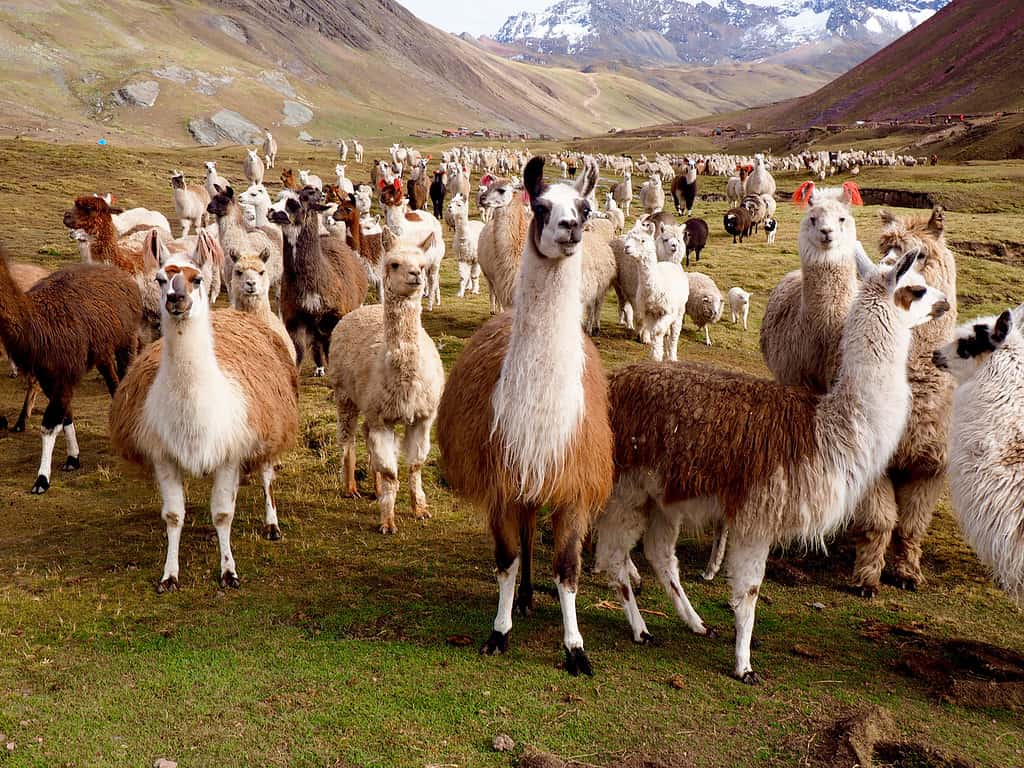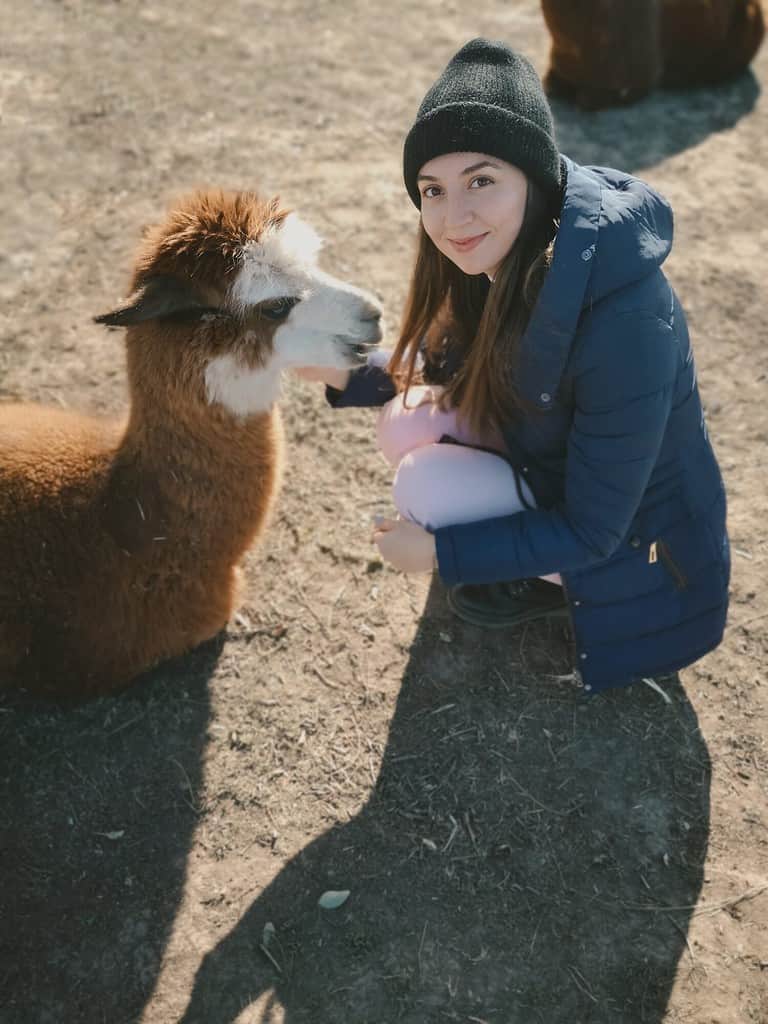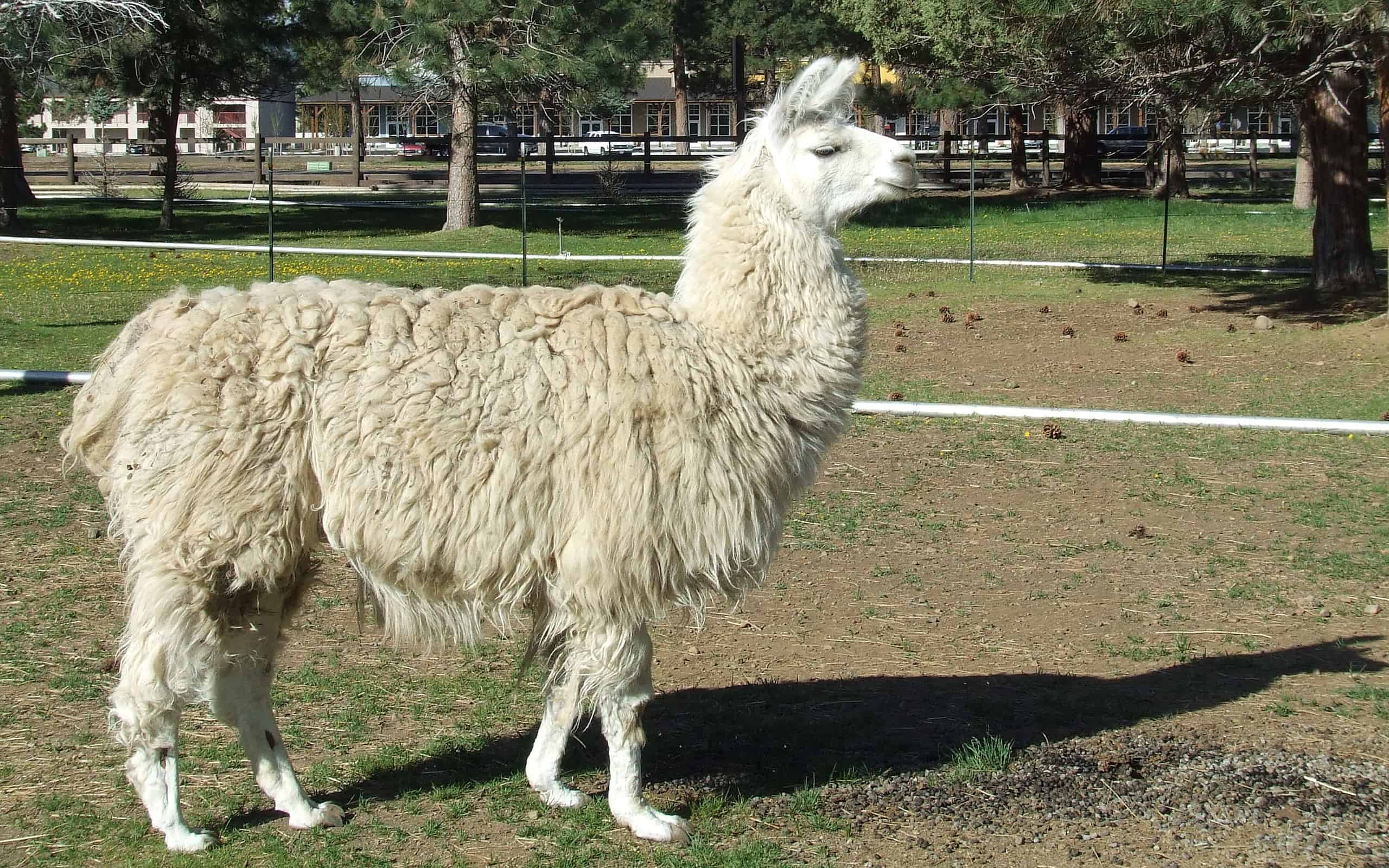Llamas (Lama glama) are mostly known for their adorable features and for their less adorable act of spitting. Regardless of their occasional spitting habit, llamas are a popular choice of animal that people buy. Whether for farming purposes, guarding other livestock, or even emotional support, llamas are often sought-after additions to a home. They are not the only animals that have been popular of late, either. Other farm animals, such as pigs and donkeys, have also been making their way into more and more homes over the years. If you are considering purchasing a llama for your home, this is the article for you. We will discuss everything llama and how much it costs to purchase and own one.

What Is a Llama, Anyway?

Llamas are mammals that belong to the Camelid family.
©Terex/ via Getty Images
Before you decide to purchase a llama, you should understand what it is. Llamas are mammals that belong to the camel family. They are considered cousins of the alpaca. While they share a family with camels, they do not share the camel’s well-known hump. Llamas come in a variety of shapes and colors, and adults range from 5 feet 7 inches to 6 feet tall. Additionally, they weigh between 290 and 440 pounds. That is a decently large animal. Also, llamas are very social creatures and prefer to live in herds.
The llama was domesticated by the Incas. The Rutgers Cooperative Research & Extension says, “Llamas were domesticated from guancos in the Andean highlands of Peru 4,000-5,000 years ago and are among the oldest domestic animals in the world.” They used the llama for wool, meat, fertilizer, and livestock protection.
Are Llamas and Alpacas the Same Thing?
While llamas and alpacas are cousins, and both can be used as emotional support animals, they are different species. Both are members of the Camelid family, along with vicuñas (Lama vicunga) and guanacos (Lama guanicoe). People believe that llamas are descended from the guanaco while alpacas are descended from the vicuña. Although they may appear similar and have similar traits, there are key differences between the llama and alpaca. First is their size. Llamas are much larger in both height and weight than alpacas. Also, llamas tend to live a little longer than alpacas.
In addition, llamas have elongated snouts with large ears, whereas alpacas have small faces with short ears. Llamas have coarse wool that can be white, gray, brown, and tan with long legs. Alpacas have soft, shaggy wool that can be black, brown, white, and tan with shorter legs. Finally, their uses differ as well. Llamas have been used by people for centuries as pack animals for carrying goods and protecting their livestock. In contrast, alpacas have mainly been used for wool or clothing production.
Why Buy a Llama?
Before we dive into lama prices and what it costs to own one, we should address the question: why buy a llama anyway? Historically, llamas have been used mainly for guarding livestock, wool, and carrying goods. Today, people may purchase a llama for similar reasons. If they own a farm or a lot of other livestock, having a llama could protect some of their smaller animals. Additionally, they may benefit from selling or using the llama’s wool. Alpaca wool is usually preferred because it is softer. Also, llamas can help carry heavier loads that people may not want to carry. Llamas can typically carry between 70 and 120 pounds.
However, there is a more recent reason that people are purchasing llamas that differs from those reasons in the past. Today, many people are purchasing llamas as emotional support animals. While these domesticated hoofed animals may not be the first animal that comes to mind when considering an emotional support animal, they have become an increasingly popular choice. When raised around people, llamas are gentle, friendly, and empathetic. Llama owners often say that they feel their pet has a sixth sense about people who are in need of some assistance.
Llama Prices by Breed

There are four species of llamas: the domesitcated llama, the alpaca, the vicuña, and the guanaco.
©Juni Samos/ via Getty Images
Four separate species of llamas exist. There are llamas, the domestic llama that we have been discussing, alpacas (Vicugna pacos), vicuñas (Vicugna vicugna), and guanacos. Of the four species, llamas are the largest and are bred to be gentle. Alpacas are smaller and shyer than llamas. Although they have also been used as emotional support animals, they are less friendly and do not like being petted by people as much. Vicuñuas are one of the two wild species of camelids and are not kept domestically. Guanacos are the other wild species of camelid, and llamas are thought to be descendants of them. Although there are four distinct species of llama (lamoid), in this article, we will solely focus on the prices of the domesticated llama (Lama glama).
Purchase Price and Price Factors
While many determining factors designate the exact price of a particular llama, the average price is between $300 and $5,000. The cost will be lower if you are interested in purchasing an untamed or untrained llama. Untrained llamas usually sell for between $400 and $900. This differs greatly from the price of trained llamas. Trained llama prices start at around $1,500.
Many things will affect llama prices. Some of the factors that can affect the price of your llama are their size, bloodline, age, temperament, and the place you are purchasing them from. Additionally, gender plays a role. Female llamas tend to be more expensive than males. In regards to color, if the llama you are interested in has a unique blend of colors to its coat, it would be more expensive than a traditionally colored llama. Also, the age and overall health of the llama determine the selling price as well.
Where to Buy Llamas?
When purchasing your llama, you have different options, and all of them vary in price. If you have connections or know someone you trust with llamas, you can purchase directly from them. The cost of getting it from someone you know would most likely be much more affordable than buying from another establishment.
If you don’t know someone who owns a llama, visiting local farms or reputable breeders and dealers in your area is the way to go. Be sure the breeder is reputable and not a mass breeder if you buy from a breeder. Mass breeders are more concerned with the quantity of their llamas, not quality. This differs from reputable breeders, who care about the quality of their llamas. When purchasing a llama, do not be afraid to do your research and ask a lot of questions about your potential new furry friend.
Tips for Purchasing Llamas

When purchasing a llama, be sure to do a pre-purchase exam.
©Daria_vg/Shutterstock.com
Below are a few things to keep in mind when purchasing your llama.
Purchase a Trained Llama
While untrained llamas will cost less initially, untrained llamas can be much harder to handle. This is particularly true if you are unfamiliar with or untrained in llama training yourself. Save yourself the stress, time, and headaches, and pay extra for a trained llama.
Do a Pre-Purchase Exam
Even if you are purchasing from someone you trust or a reputable breeder, doing a pre-purchase exam of your selected llama is always a good idea. Have a veterinarian come out and expect the health of your llama. While this will have a cost, it can save you higher costs of an unknown medical or health issue with your llama.
Buy More than One Llama
Llamas are very social creatures and do better in herds. While it is important not to over-socialize your llamas, they do better when they have other llamas to socialize with. The only reason you should have just one llama is if you are using it as a guard animal. However, even so, llamas do best when they are together, and having more of them can help strengthen their strong herding instincts. Additionally, if you have just one llama, it may get lonely. Lonely llamas can sometimes turn aggressive.
Costs of Upkeeping a Llama
Now that you know llama prices, let’s discuss what it costs to upkeep a llama.
Feeding Your Llama
While llamas may be considered a cheaper farm animal to own, they still require a monthly fee dedicated to their food. Llamas are herbivores and eat a plant-based diet. A typical meal for a llama could be alfalfa hay, corn silage, or grass. If you want your llama to be extra healthy, you may want to add additional minerals to their diet. The average monthly cost of feeding your llama is about $300.
Vet Care for Your Llama
Like all other animals you own, your llama will need occasional vet care. The exact price of the veterinary care depends upon which vet you use and the health of any particular care needed for your llama. You should have monthly check-ups with your vet because llamas are susceptible to parasites and bacteria that could be problematic to your llama’s health. Other examples of potential routine care for your llama may include purchasing vitamins and receiving vaccinations. For emergency visits or health-specific visits, those prices would be higher.
Shearing Your Llama
If you choose to hire a professional shearer rather than shear your own llama, it will cost an additional charge. The industry standard for this service is typically between $25-$35. That does not include the farm visit fee, which is usually around $80.00. Shearing your llama is good for their health, particularly in the summer when they are at risk of overheating. If you choose to shear your own llama, you will need to purchase your own shearing equipment.
Recap of Estimated Cost of Purchasing and Upkeeping a Llama
Estimated Cost of Purchasing a Llama
The average price of a llama is between $300 and $5,000. Here is a table summarizing a general review of what makes llamas more expensive or less expensive.
| Llama Traits | Cheaper | More Expensive |
|---|---|---|
| Age | Older | Younger |
| Gender | Males | Females |
| Bloodline | Some health issues | No health issues |
| Place of Purchase | Non-reputable breeder OR a known connection | Reputable breeder |
| Color | Ordinary coloring | Unique or mixed coloring |
| Training | Untrained | Trained |
| Size | Small | Large |
Estimated Cost of Upkeeping a Llama
After purchasing the llama, there is still the cost of upkeeping your llama. Below is a table that summarizes the main areas of upkeep you will need to maintain.
| Additional Cost Factor | Description | Average Monthly Cost |
|---|---|---|
| Feeding Your Llama | Llamas are herbivores and eat alfalfa hay, corn silage, or grass. | $300 dollars a month |
| Vet Care for Your Llama | Llamas are prone to bacteria and parasites and need preventative care monthly. | Preventative care averages from $20 to $40 dollars per month. Specialized care or emergency care is dependent upon the situation. |
| Shearing Your Llama | Shearing is important for your llama’s health during the hot summer months to help prevent overheating. | The industry standard is $25-$35. The additional farm visit fee is around $80. |
Thank you for reading! Have some feedback for us? Contact the AZ Animals editorial team.







